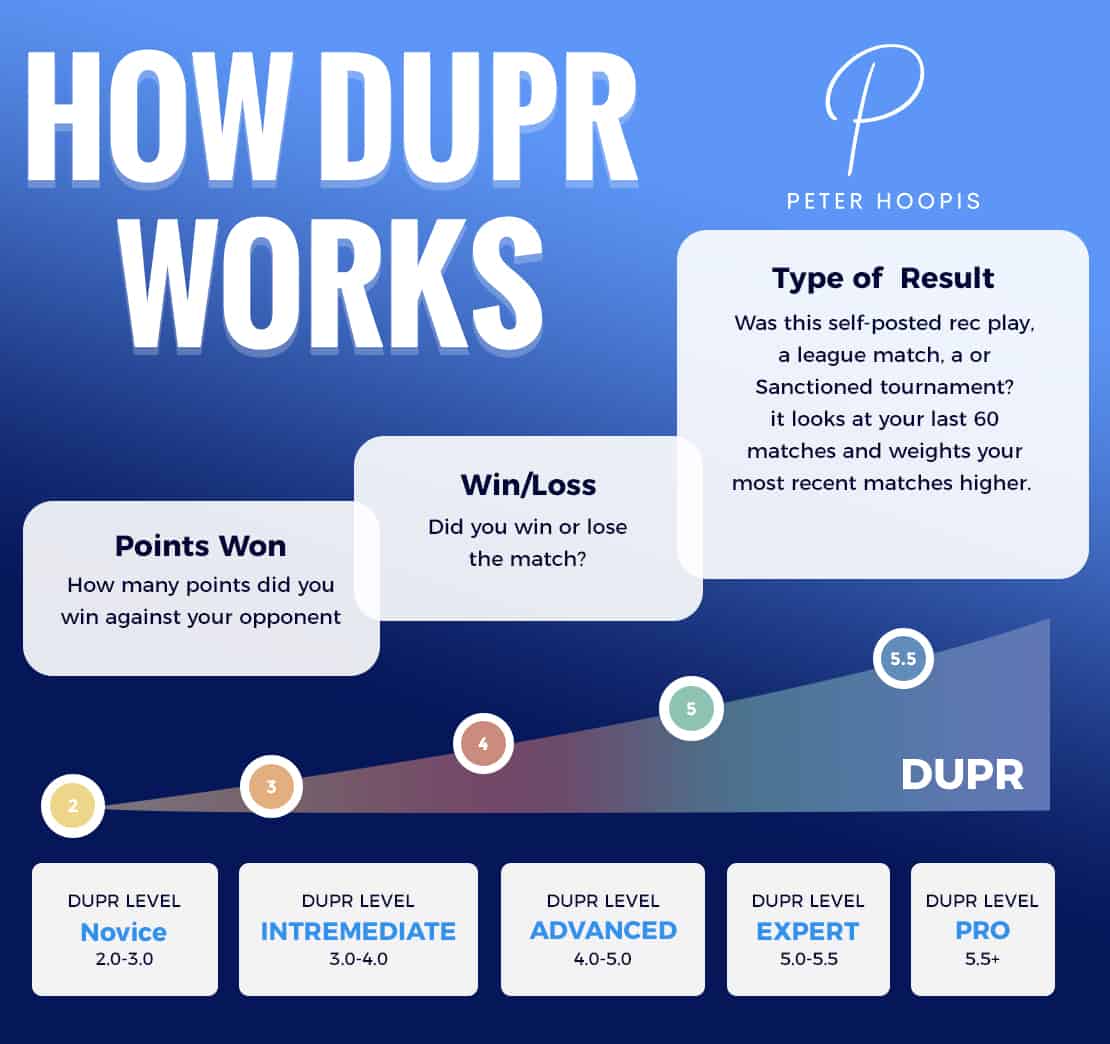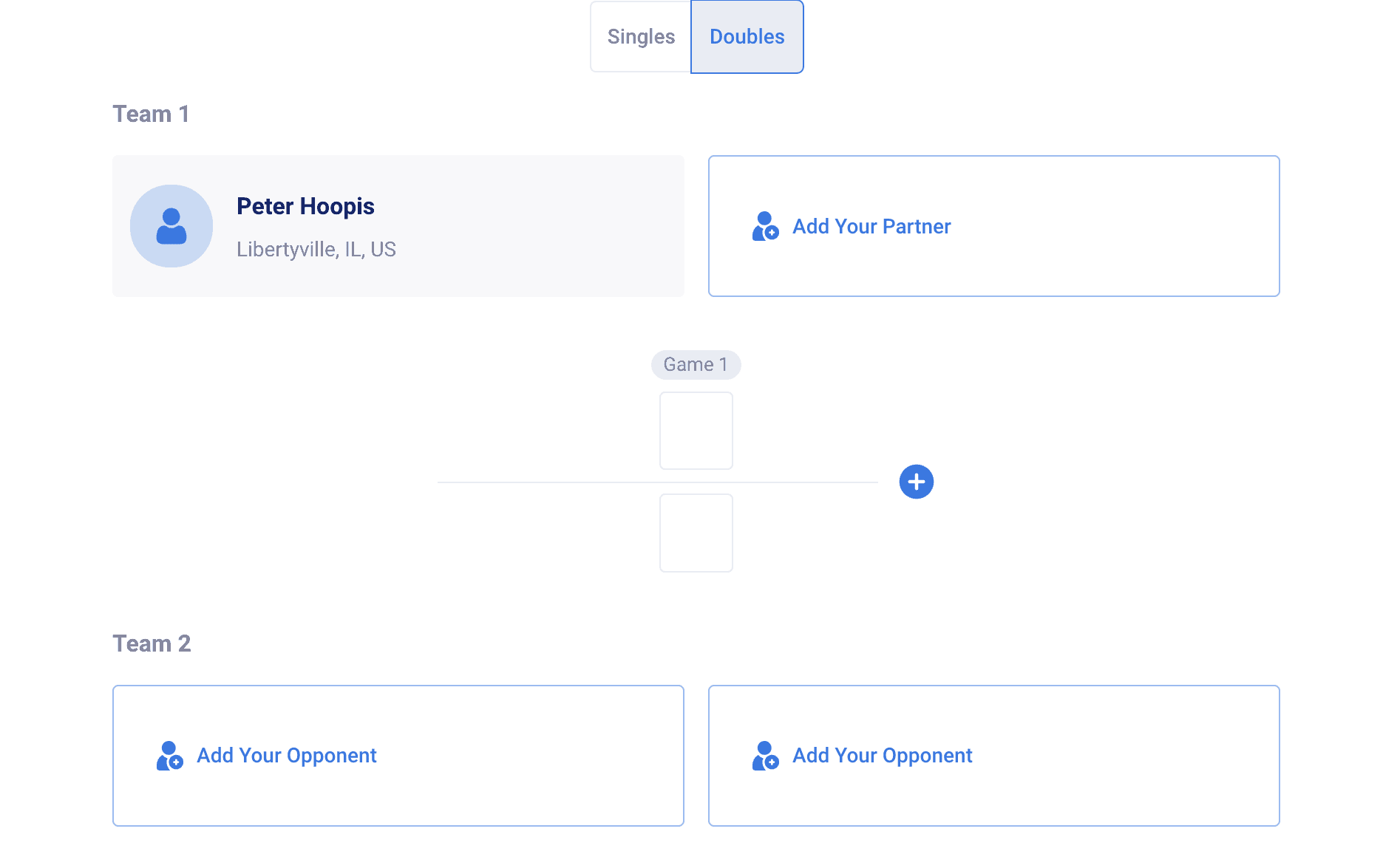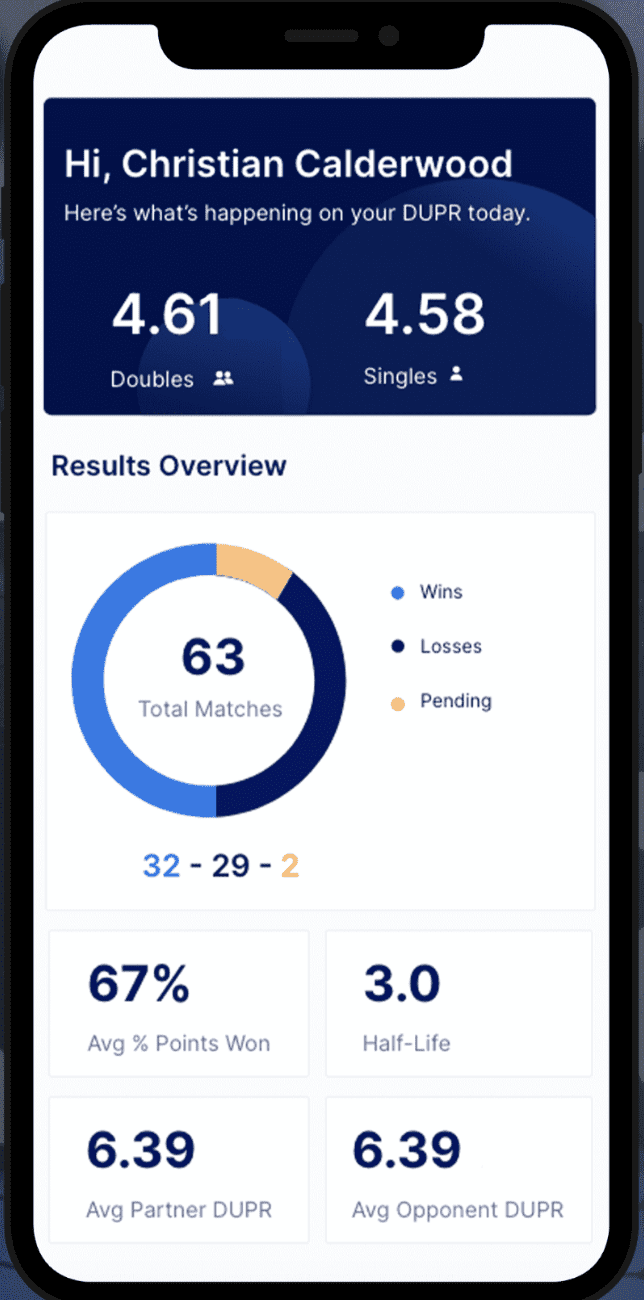Ever wondered how good you really are at pickleball? Or maybe you’ve heard other players chatting about their “DUPR” and thought, “Their what now?”
Trust me, you’re not alone!
With pickleball exploding faster than a pop serve, everyone from your next-door neighbor to NFL stars is picking up a paddle. But here’s the thing – with millions of us now playing, we needed a better way to figure out who should play with whom.
Enter the DUPR rating system. (And yes, I’ll tell you what those letters stand for in just a minute!)
Think of DUPR like your pickleball report card – except way more fun and actually useful. Whether you’re a total newbie who’s still mastering the dink, or someone who can bang out an around-the-post shot with their eyes closed, your DUPR rating has something important to tell you.
In this post, we’re going to break down everything you need to know about DUPR ratings. No complicated jargon, I promise! Just straight talk about:
- What this number means for your game
- Why it’s different (and better!) than other rating systems
- How it can help you find the perfect playing partners
- And most importantly – how to use it to level up your pickleball game!
Ready to decode the DUPR mystery? Let’s dig in!
What Is a DUPR Rating?
Ever heard the saying “numbers don’t lie”? Well, back in 2021, Steve Kuhn (the founder of Major League Pickleball) had a brilliant idea. Why not create a rating system that actually tells the truth about how good you are at pickleball?
And that’s how DUPR was born!
“But wait,” you might be thinking, “what in the world does DUPR mean?”
It stands for Dynamic Universal Pickleball Rating (now presented by Delaware Life). I know, kind of a mouthful – but stick with me here!
Here’s the problem DUPR wanted to fix: Picture showing up to a tournament, ready to play your heart out, only to find out your opponent “self-rated” themselves way lower than their actual skill level. Not cool, right? (We see you, sandbaggers! 👀)
These days, DUPR is led by CEO Tito Machado, and they’re making huge moves in the pickleball world. Just recently, they partnered with SPORTIME, one of the biggest racket sport providers in the country, to help grow the game even more. Talk about pickleball power moves!
So how does it work?
DUPR uses a scale from 2.000 to 8.000 (and yes, those decimal points matter!). To put that in perspective:
- Your buddy who just started playing last week? Probably around 2.000
- The amazing Ben Johns? He’s rocking a 7.334 in doubles at time of writing
- The incredible Anna Leigh Waters? She’s crushing it with a 6.65 in doubles
But here’s what makes DUPR really special – it’s actually two ratings in one! You get:
- A singles rating (for when you’re flying solo)
- A doubles rating (for when you’ve got a partner in crime)
And get this – DUPR doesn’t just care if you win or lose. It looks at HOW you win or lose. Did you barely squeak by 11-9, or did you dominate 11-0? That matters! This attention to detail makes DUPR super accurate at figuring out your true skill level.
The best part?
DUPR doesn’t care about your age or gender. Whether you’re 18 or 80, male or female, everyone uses the same scale. It’s all about how you play the game!
Your rating changes as you play more games, which means it’s always keeping up with your improvement. (Or those rare off days we all have… but let’s not talk about those! 😉)
More and more clubs and facilities are adopting DUPR as their official rating system – because let’s face it, when you’re trying to find the perfect match-up for a game, you want numbers you can trust!

How is the DUPR Calculated?
The Secret Sauce of DUPR Calculations:
First things first: your DUPR rating isn’t just about wins and losses. It’s way smarter than that! Here’s what goes into the mix:
Who You Play Against
Think of it like this: beating a 5.0 player means more than beating a 3.0 player. Makes sense, right? DUPR looks at your opponent’s rating to figure out how impressive your win (or loss) really was.
The Score Matters – A Lot!
Did you demolish your opponent 11-2? Or did you barely squeeze by 11-9? DUPR cares about these details! A bigger win margin usually means more points for your rating. (And yes, a close loss might not hurt your rating as much as you’d think!)
It’s All About Recent History
Your latest games count more than those pickup games from six months ago. DUPR keeps things fresh by giving more weight to recent matches. Pretty smart, huh?
But Here’s the Cool Part…
Every time you play a rated match, DUPR’s algorithm:
- Looks at who you played
- Checks out the score
- Considers how recent the match was
- Mixes it all together with some fancy math
- Updates your rating automatically
And don’t worry about tanking your rating with one bad day – DUPR is designed to spot your true skill level over time. It takes multiple matches to see big changes in your rating.
Quick Tip: Want to improve your DUPR rating? Focus on playing lots of competitive matches against players at or above your level. And remember – even losses can help your rating if you keep the scores close!
Remember: Your rating isn’t set in stone. It’s “dynamic” (that’s what the D in DUPR stands for!) and changes as you play more matches. Think of it as your pickleball journey tracker!
Have you checked your DUPR rating lately? You might be surprised at how well you’re doing! 🏓

What are the Benefits Of the DUPR System?
Finding Your Perfect Match Ever shown up to play and thought, “These games are NOT even close”? DUPR helps solve that problem! It matches you with players at your level, making games more fun and competitive. No more accidental crushings or feeling totally outmatched!
Tournament Time Made Easy
Remember the old days of “trust me, I’m a 3.5”? Those days are gone! Tournaments using DUPR can:
- Seed players accurately
- Create fair brackets
- Stop those sneaky sandbaggers in their tracks
- Help you find the right division to play in
Track Your Progress Like a Pro
There’s something super satisfying about watching your rating climb! DUPR gives you:
- Real-time updates after matches
- A clear picture of your improvement
- Separate ratings for singles and doubles
- Actual data to show your pickleball buddies (bragging rights included!)
No More Gender or Age Bias
Here’s something really cool about DUPR – it doesn’t care who you are, just how you play. That means:
- Men and women use the same scale
- Age doesn’t affect your rating
- It’s all about your game, not your demographics
Making New Pickleball Friends Want to find people to play with at your level? DUPR makes it easy! Just check those numbers and you’re good to go. It’s like a matchmaking service for pickleball players! 😉
Club and League Organization More and more clubs (like SPORTIME) are using DUPR to:
- Organize level-based play
- Run leagues and ladders
- Set up round robins
- Create fun, competitive events
The Truth Factor Let’s be honest – nobody likes a sandbagger. DUPR keeps things real by:
- Using actual match results
- Considering margin of victory
- Updating automatically
- Being harder to manipulate than self-rating systems
Whether you’re a casual player or a serious competitor, having a DUPR rating just makes pickleball life easier. Plus, it’s free! Who doesn’t love that?
Ready to start tracking your DUPR rating? Your next great match could be just a number away! 🏓
Have you noticed any differences in your local games since people started using DUPR?


DUPR Goes to College!
Remember when pickleball was just something you played at the local rec center? Well, times have changed – pickleball has hit college campuses in a big way, and DUPR is right there making it happen!
The College Connection In 2023, DUPR made a huge move by partnering with the APP (Association of Pickleball Professionals) to launch official collegiate pickleball. Think of it like NCAA tennis, but with more dinks and around-the-post shots!
Here’s what makes collegiate DUPR special:
Team Rankings That Make Sense
- Schools can see exactly how they stack up against other colleges
- Teams get ranked based on their players’ DUPR ratings
- Makes it super easy to organize fair inter-collegiate competitions
Finding Hidden Talent Colleges can now:
- Scout potential pickleball athletes
- Track player development
- Compare talent across different regions
- Build competitive programs based on real data
Tournament Time The collegiate scene uses DUPR for:
- National Championships seeding
- Regional tournament organization
- Creating fair brackets for both team and individual events
- Making sure schools compete against similar-level programs
Growing the College Game DUPR has become a crucial part of:
- Building legitimate college pickleball programs
- Helping schools start new teams
- Creating competitive divisions
- Supporting the push for official NCAA recognition
Want to know something cool? Some colleges are even starting to look at DUPR ratings when considering pickleball scholarships! The sport is growing that fast at the collegiate level.
Are you involved in college pickleball? I’d love to hear about your experience with DUPR on campus!
Why Ratings Matter (And Why You Should Care!)
Let’s get real for a minute – nobody likes getting crushed on the pickleball court. And nobody wants to be that player who accidentally dominates newer players either. This is exactly why ratings matter so much!
Finding Your Perfect Match
DUPR has this thing called “DUPR Neutral” – it’s when players are within 0.250 points of each other. Think of it like Goldilocks: not too strong, not too weak, but just right! When you play someone in this range, you’re likely to have:
- Competitive games that go back and forth
- Points that make you work (but don’t destroy you)
- Matches that help both players improve
- Fun rallies where everyone gets to play!
Making Tournaments Fair and Fun
Remember that tournament where you felt completely outmatched? Or maybe you were the one doing all the outmatching? Well, DUPR helps solve that problem by:
- Creating balanced brackets
- Preventing sandbagging (we see you, rating manipulators! 👀)
- Making sure everyone has a fighting chance
- Helping tournament directors sleep better at night!
Welcoming Newbies with Open Arms
Let’s face it – pickleball can be intimidating when you’re just starting out. But DUPR makes it easier for newcomers by:
- Helping them find other beginners
- Tracking their improvement
- Building confidence through fair matches
- Creating a clear pathway for improvement
The Big Picture Benefits
Having a reliable rating system like DUPR does even more:
- Helps clubs organize level-based play
- Makes league play more competitive
- Lets you track your progress over time
- Shows you exactly where you need to improve
And here’s something cool – with DUPR’s growing adoption by major organizations (like SPORTIME and collegiate programs), your rating can follow you anywhere you play. Whether you’re hitting at your local rec center or traveling to a tournament across the country, your DUPR rating helps you find the right games.
Pro Tip: Want to improve your rating? Focus on playing people within that 0.250 range above your current DUPR. It’s challenging enough to help you grow, but not so tough that you’ll get discouraged!
Have you noticed how much more fun pickleball is when you’re playing with people at your level? That’s the DUPR difference! 🏓
Related: The Best Pickleball Bags Ranked and Reviewed
Related: The Best Pickleball Paddles Ranked and Reviewed
How Do You Get A DUPR Rating?
Getting Started is Super Easy First things first – head over to dupr.com and create your free account. Yep, you read that right – it’s FREE! Just sign up with your email, and you’re ready to roll.
But Wait… Where’s My Rating?
Don’t panic if you don’t see a number right away! To get your initial DUPR rating, you’ll need to:
- Play at least 3 matches against rated players
- Record those match results in the system
- Make sure to include the exact scores
Playing Your First Rated Matches
Here’s the cool part – you can start playing rated matches right away! Look for:
- Local DUPR-sanctioned tournaments
- Club events that use DUPR
- Leagues that track DUPR ratings
- Apps or facilities that partner with DUPR
Tracking Your Games
After each match, make sure to:
- Log in to your DUPR account
- Enter the match scores
- Include your opponent’s info
- Double-check those numbers (because accuracy matters!)
Pro Tip: Both players should verify match results. It’s like a virtual handshake after the game!
What About My Old Tournament Results?
Good news! If you’ve played in DUPR-sanctioned events before creating your account, those results might already be in the system. Once you claim your profile, these matches could count toward your rating.
The Magic Number Once you’ve got those first few matches recorded:
- DUPR’s algorithm works its magic
- Your initial rating appears
- You can start tracking your progress
- The more you play, the more accurate it gets!
Keep It Active To maintain an accurate rating:
- Play regularly
- Record all your competitive matches
- Keep your profile updated
- Challenge yourself with matches in your DUPR range
Remember – Everyone Starts Somewhere Don’t stress about your initial number! Your DUPR rating is meant to grow with you as you improve. The key is just getting started.

The DUPR App
The app is really nice and easy to use, which is important to get players to use it. It shows your DUPR rating, wins and losses, average points won, average opponent DUPR, match history, and much more! You can find your club in the system to keep track of your local events and look up players anywhere. Great resource! And again, its free!

Explain How It Differs From Other Rating Systems
Ever felt confused by all the different rating systems in pickleball? Let’s break down what makes DUPR special!
The Old School Systems Remember these?
- USAPA/USA Pickleball (2.0-5.5)
- Self-Rating (yeah, that honor system thing…)
- Club Ratings (every club seems to have their own way!)
- IFP Tournament Player Rating (ITPR)
But DUPR Takes a Fresh Approach
More Precise Numbers Instead of broad categories like “3.5” or “4.0”, DUPR gives you super specific ratings:
- Goes from 2.000 to 8.000
- Uses three decimal places
- Shows tiny improvements
- Makes it easier to find your true skill level
It’s All About the Data DUPR is like the sports analytics of pickleball:
- Tracks actual game scores
- Considers who you played against
- Looks at margins of victory
- Updates automatically after matches
No More Gender Split Here’s a game-changer – while other systems often separate men and women:
- DUPR uses ONE scale for everyone
- Your rating is based purely on how you play
- Makes mixed doubles easier to organize
- Shows true skill regardless of age or gender
The Dynamic Difference Unlike static systems, DUPR:
- Changes with every match you play
- Weights recent games more heavily
- Adjusts quickly to improvement
- Can’t be “frozen” like some other ratings
Harder to Game the System Sorry, sandbaggers! DUPR makes it tough to manipulate because:
- You can’t self-rate
- Every match counts
- Scores must be verified
- The algorithm catches unusual patterns
Tournament Friendly DUPR makes tournament life easier by:
- Creating fairer brackets
- Using real data for seeding
- Preventing rating shopping
- Making division placement clearer
The Universal Factor Maybe the biggest difference? DUPR is becoming the universal language of pickleball:
- Used by major tournaments
- Adopted by clubs nationwide
- Recognized by pro tours
- Growing internationally
Quick Comparison:
DUPR vs Traditional Rating Systems
| Traditional Systems | DUPR |
|---|---|
| Broad categories (3.0, 3.5, etc.) | Precise numbers (3.842, 4.156, etc.) |
| Often self-rated | Based on actual match results |
| Separate men’s/women’s scales | One universal scale |
| Static ratings | Dynamic updates |
| Club/region dependent | Nationally recognized |
| Manual updates | Automatic updates after matches |
| Limited verification | Score verification required |
| Susceptible to sandbagging | Algorithm detects unusual patterns |
| Limited historical data | Comprehensive match history |
| Regional variations | Standardized nationwide |
Here’s the bottom line: DUPR isn’t just another rating system – it’s changing how we think about skill levels in pickleball. And isn’t that what we need as the sport keeps growing?
Wrapping It Up – Your DUPR Journey Starts Here!
If you’ve made it this far, you probably realize that DUPR is more than just another rating system – it’s becoming the universal language of pickleball! Whether you’re a kitchen warrior or just starting out, having a DUPR rating opens up a whole new world of pickleball possibilities.
Think about it:
- No more guessing about skill levels
- Better matches with the right partners
- Fairer tournaments
- Real proof of your improvement
- A rating that travels with you anywhere you play
The best part? The pickleball community is embracing DUPR in a big way. From local rec centers to major tournaments, collegiate programs to private clubs like SPORTIME, more players are jumping on the DUPR train every day.
Ready to Get Started?
- Create your free DUPR account
- Log those matches
- Watch your rating evolve
- Connect with players at your level
- Start having more fun on the courts!
Remember – your DUPR rating isn’t just a number. It’s your ticket to better games, fairer matches, and more fun on the pickleball court. And isn’t that what this amazing sport is all about?
See you on the courts! 🏓
Pro Tip: Share this article with your pickleball buddies who are still confused about DUPR. They’ll thank you later! 😉


